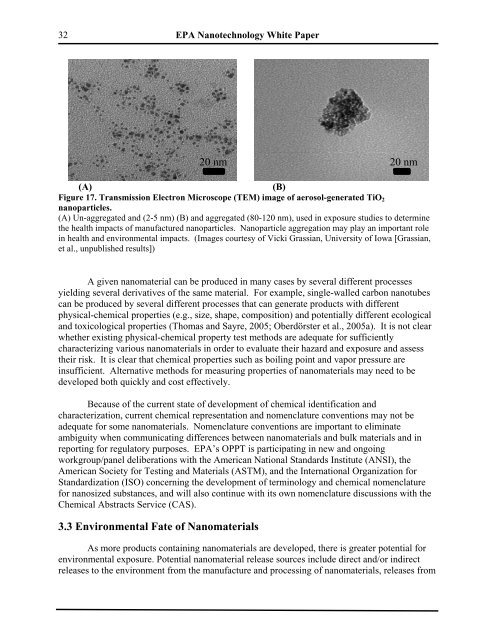Nanotechnology White Paper - US Environmental Protection Agency
Nanotechnology White Paper - US Environmental Protection Agency
Nanotechnology White Paper - US Environmental Protection Agency
Create successful ePaper yourself
Turn your PDF publications into a flip-book with our unique Google optimized e-Paper software.
32 EPA <strong>Nanotechnology</strong> <strong>White</strong> <strong>Paper</strong><br />
20 nm 20 nm<br />
(A)<br />
(B)<br />
Figure 17. Transmission Electron Microscope (TEM) image of aerosol-generated TiO 2<br />
nanoparticles.<br />
(A) Un-aggregated and (2-5 nm) (B) and aggregated (80-120 nm), used in exposure studies to determine<br />
the health impacts of manufactured nanoparticles. Nanoparticle aggregation may play an important role<br />
in health and environmental impacts. (Images courtesy of Vicki Grassian, University of Iowa [Grassian,<br />
et al., unpublished results])<br />
A given nanomaterial can be produced in many cases by several different processes<br />
yielding several derivatives of the same material. For example, single-walled carbon nanotubes<br />
can be produced by several different processes that can generate products with different<br />
physical-chemical properties (e.g., size, shape, composition) and potentially different ecological<br />
and toxicological properties (Thomas and Sayre, 2005; Oberdörster et al., 2005a). It is not clear<br />
whether existing physical-chemical property test methods are adequate for sufficiently<br />
characterizing various nanomaterials in order to evaluate their hazard and exposure and assess<br />
their risk. It is clear that chemical properties such as boiling point and vapor pressure are<br />
insufficient. Alternative methods for measuring properties of nanomaterials may need to be<br />
developed both quickly and cost effectively.<br />
Because of the current state of development of chemical identification and<br />
characterization, current chemical representation and nomenclature conventions may not be<br />
adequate for some nanomaterials. Nomenclature conventions are important to eliminate<br />
ambiguity when communicating differences between nanomaterials and bulk materials and in<br />
reporting for regulatory purposes. EPA’s OPPT is participating in new and ongoing<br />
workgroup/panel deliberations with the American National Standards Institute (ANSI), the<br />
American Society for Testing and Materials (ASTM), and the International Organization for<br />
Standardization (ISO) concerning the development of terminology and chemical nomenclature<br />
for nanosized substances, and will also continue with its own nomenclature discussions with the<br />
Chemical Abstracts Service (CAS).<br />
3.3 <strong>Environmental</strong> Fate of Nanomaterials<br />
As more products containing nanomaterials are developed, there is greater potential for<br />
environmental exposure. Potential nanomaterial release sources include direct and/or indirect<br />
releases to the environment from the manufacture and processing of nanomaterials, releases from
















